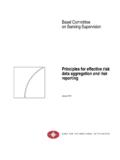Transcription of Basel II & Credit Risk Management: Risk Data and …
1 Basel II & Credit Risk Management: Risk Data and Modeling Considerations Deloitte & Touche LLP. Copyright 2011, SAS Institute Inc. All rights reserved. #analytics2011. History of Banking Capital and Basel The Basel Accord was initially drafted in 1988 to improve the safety and soundness of the global banking system by enhancing the risk measurement and capital adequacy within Banks Aimed at placing internationally active banks on comparable footing with respect to capital requirements Progression of capital level policies prior to the Basel Accord Bank capital declined to FRB initiated go slow policy Basel Accord led to adoption of risk- < 20% with respect to expansion weighted framework for assessing proposals capital adequacy of 8 percent 1870 - 1910 1915 - 1930 1970 1982 1988.
2 Averaged at 13% before Great Ratio of total capital to total Depression assets for insured banks = 6%;. ratio for largest banks = %. #analytics2011. Content Copyright 2011 Deloitte Development LLC. All rights reserved. Copyright 2011, SAS Institute Inc. All rights reserved. Basel I - History and Overview The Basel Committee on Banking Supervision (BCBS) issued the first Basel Accord in 1988, and a market risk amendment in 1996. Overview Created a basic, global risk management framework for market and Credit risk (did not account for diversification or operational risk). Established standard supervisory and disclosure requirements Created a top down Risk Weight based approach for Credit risk Assigned an 8% capital charge to Risk Weighted Assets #analytics2011. Content Copyright 2011 Deloitte Development LLC.
3 All rights reserved. Copyright 2011, SAS Institute Inc. All rights reserved. Basel II - History and Overview Basel II refers to a comprehensive revision to the Basel I standards issued by the BCBS in 2004, and finalized in 2006. Overview Provides more flexibility in calculating minimum regulatory capital Improves risk sensitivity of regulatory capital framework, while maintaining current capital levels in the system Broadly aligns regulatory capital rules to economic capital used in large banks Incentivizes risk management and risk mitigation processes and practices #analytics2011. Content Copyright 2011 Deloitte Development LLC. All rights reserved. Copyright 2011, SAS Institute Inc. All rights reserved. US Basel II Final Rules Overview Basel II Final Rules were published in 2007.
4 Delayed due to Legislative and regulatory concerns Retention of Leverage Capital ratio in the limits risk sensitivity of the Final Rule, but was a non-negotiable item with some legislators and regulators Scope of applicability in the is limited to mandatory core banks and opt-in banks Core Banks: Bank Holding Companies (BHCs) and/or Depository Institutions (DI) with Total Assets > $250 B, or Foreign Exposure > $10 B. #analytics2011. Content Copyright 2011 Deloitte Development LLC. All rights reserved. Copyright 2011, SAS Institute Inc. All rights reserved. Basel II Timelines in the US. A parallel run calculating both Basel I and Basel II. capital of at least four consecutive quarters must be completed as part of Basel II implementation Effective date Financial Institutions classified as US Banks Four Quarters of for US Basel II CORE Banks enter transition adopt Basel I Internal Parallel Run Final Rules period 1988 1996 2008 2009 18 month Transition Period Q1 Q2 Q3 Q4.
5 #analytics2011. Content Copyright 2011 Deloitte Development LLC. All rights reserved. Copyright 2011, SAS Institute Inc. All rights reserved. Basel III. Basel III guidance was issued by BCBS as a comprehensive response to the global Credit crisis. Basel II and Basel III, together, replace most elements of Basel I. Basel III frameworks primary focus is on revised capital standards (such as leverage ratios), stronger capital definitions, and systemic risk overlays along with a new international framework for liquidity risk. Revised capital standards Leverage ratios were introduced as a supplementary measure Stronger capital definitions Market and Credit Risk Revisions were introduced Market risk capital can possibly increase by 2 4 times leading to smaller trading book. Significant Credit risk capital increases for securitizations and capital market products are likely to lead to reduced activity and squeeze profitability.
6 Liquidity Risk A new framework for liquidity risk measurement, standards, and monitoring. #analytics2011. Content Copyright 2011 Deloitte Development LLC. All rights reserved. Copyright 2011, SAS Institute Inc. All rights reserved. Core Banks Implementing Basel II*. * Source: FFIEC #analytics2011. Content Copyright 2011 Deloitte Development LLC. All rights reserved. Copyright 2011, SAS Institute Inc. All rights reserved. Key Data Considerations for Risk programs Copyright 2011, SAS Institute Inc. All rights reserved. #analytics2011. Key Data Considerations for Risk programs Data Standardization Historical Reference Data Data Unification Data Lineage Risk Data Data Considerations Hierarchy Single Loss Event Customer Data View Metadata and Data Governance #analytics2011. Content Copyright 2011 Deloitte Development LLC.
7 All rights reserved. Copyright 2011, SAS Institute Inc. All rights reserved. Data Standardization Data standardization refers to building a common language for sharing of key business information across organization and users ( a single version of truth). The key components of data standards are: Usability Standardize the quality of information Transferability Enable an organization wide perspective Measurability Provide baseline metric to capture viability of data Data standardization issues are common in large Bank Holding Companies and Financial Institutions. These issues can result in the need to create additional transformation modules, translation efforts and exhaustive data validation. Such issues delay the process of system integration. Key Industry Observation Solutions from the Industry Acquisition of systems and use of Efforts have been undertaken to multiple vendor product within a bank had standardize information right at the resulted in a lack of uniformity of similar source/ point of sale.
8 Some firms have data. For example: the legal entity was left the original systems as is and instead referred to by different identifiers & have created central translation systems values across the firm. to aid with the standardization of data M&A and consolidation at major banks values. over the last decade has resulted in Most of the banks have created central numerous disconnected systems with data warehouses and reporting data duplicated data sets. marts to bring the data from various Business Units together and allow for centralized data management. #analytics2011. Content Copyright 2011 Deloitte Development LLC. All rights reserved. Copyright 2011, SAS Institute Inc. All rights reserved. Reference Data Unification Reference data typically refers to static or slowly changing dimensional data that is used across systems, such as customer and legal entity identifiers, FX rates, external ratings, contract id etc.
9 Basel calculations, Credit risk reports, loss-event monitoring and other risk and finance programs require clean and reliable reference data. Most Financial Services firms face issues affecting availability, accessibility, accuracy and unification of key reference data. Key Industry Observation Solutions from the Industry Most large Financial Services Some firms have instituted new programs Organizations and banks have issues in to collate customer information, within uniquely identifying customers across reason, to create a single customer view legal entities/jurisdictions across the firm. Most of the Bulge bracket banks in US The dispersed reference data within the found it difficult to assess the Credit risk in firm (like counterparty info) are mapped their loan portfolio due to the inconsistent to the standardized data located in view (because of inconsistent capture of centralized data-mart.)
10 Risk type data like counterparty info etc.). of reference data across the source systems within the firm. #analytics2011. Content Copyright 2011 Deloitte Development LLC. All rights reserved. Copyright 2011, SAS Institute Inc. All rights reserved. Data Hierarchy Today's organizations have complex business structures with hundreds of subsidiaries, affiliate sub-affiliate relationships, business units. The sum of these relationships can be defined as an organizational hierarchy. Most financial organizations find it challenging to create a counterparty hierarchy understand the , organizational hierarchy of their customers based on legal entities Organizational data hierarchy (entities, business units etc.). and product data hierarchy are especially useful when it comes to the consistent usage of data for risk, marketing, fraud and operations across products, countries and region.







